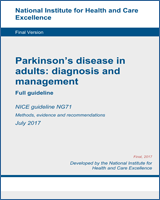NCBI Bookshelf. A service of the National Library of Medicine, National Institutes of Health.
Parkinson’s disease in adults: diagnosis and management. London: National Institute for Health and Care Excellence (NICE); 2017 Jul. (NICE Guideline, No. 71.)
Table C1Communicating with people with Parkinson’s and their carers (2005) (Adapted rom Parkinson’s Disease Society report33)
| Principle | Comment |
|---|---|
| General | |
| Maintain a good knowledge of Parkinson’s disease including the symptoms, comorbidities, care and treatment. | All staff who come into contact with people with Parkinson’s need to have training and updating on the core symptoms, pharmacology and care. |
| Use clear language and avoid medical jargon when communicating with people with Parkinson’s. | Essential. |
| Check if the person has understood information provided. | Essential. |
| Give the person extra time to respond to questions. | Essential. |
| Ensure information is appropriate, accessible and available in a range of formats. | Essential. |
| Provide an appropriate setting to communicate, eg a quiet room without interruptions or distractions. | Essential. |
| Diagnosis | |
| Communicate the diagnosis in a manner that is sensitive to the needs of the individual, ie if the person wants more information, make this available; if they demonstrate shock or bewilderment, offer a follow-up appointment for further discussion of the symptoms and treatment. | Essential. |
| Allow extensive opportunities for questions and discussion. | The consultation time should be sufficient to allow for this. |
| Offer a follow-up discussion. | Essential. |
| If the consultation reveals a demand for additional specialist information, the person should be referred promptly to the relevant professional (eg Parkinson’s nurse, psychiatrist, speech and language therapist, counsellor). | Essential. |
| Offer written information to supplement the diagnosis. This should include details of specialist organisations such as the Parkinson’s Disease Society (PDS). | Essential. |
| Put the person in contact with specialist support, eg Parkinson’s nurse, PDS community support worker. This should include multidisciplinary support (speech and language therapy, physiotherapy, occupational therapy, social workers). | Essential. |
| Provide information for carers. | I mportant but not in all circumstances – the needs of the patient should come first. |
| Maintenance | |
| Provide the person with a point of contact for further information. | The PDS recommends that all people with Parkinson’s should have access to a PDNS. |
| Ensure the person has relevant and current information about the condition and treatment specific to their needs and stage of the condition. Provide them with information about all their options, eg medications, home care, therapy. | Essential. Frequency of reviews varies according to the individual but is optimally 6 months. Consultation can take place additionally and in the interim via telephone and email contact. |
| Consult the person regularly about their physical and emotional needs and financial needs. | Essential. |
| Consult the carer about the physical and emotional needs of the person they are caring for, and their own support needs. | Essential. |
| If/when the person goes into hospital, ask them whether they are self medicating, and, if so, facilitate this with access to their drugs at the times prescribed for them. | Essential. |
| Offer the person access to self-management resources, eg the Expert Patient Programme, if appropriate. | Essential. |
| Advanced stage care | |
| Ensure that people and carers receive regular information about the condition, the medications, the financial support and the support networks. | These should be available in a variety of formats, such as print, audio and/or video. |
| Ensure that staff are aware of the complexities of this stage of the disease and care for their holistic needs and those of their carers including emotional, spiritual and psychological needs. | Essential. |
- Parkinson’s Disease Society Communication Table - Parkinson’s disease in adults:...Parkinson’s Disease Society Communication Table - Parkinson’s disease in adults: diagnosis and management
Your browsing activity is empty.
Activity recording is turned off.
See more...
